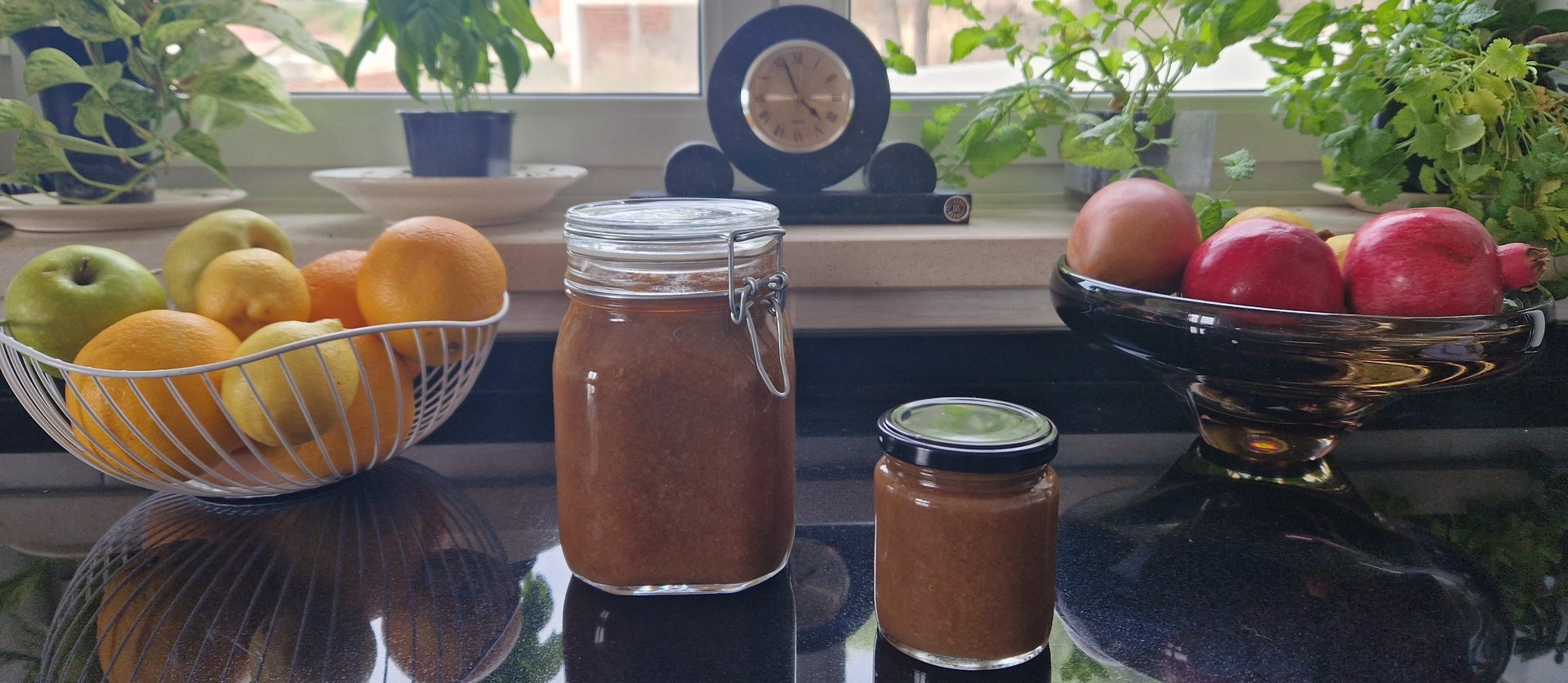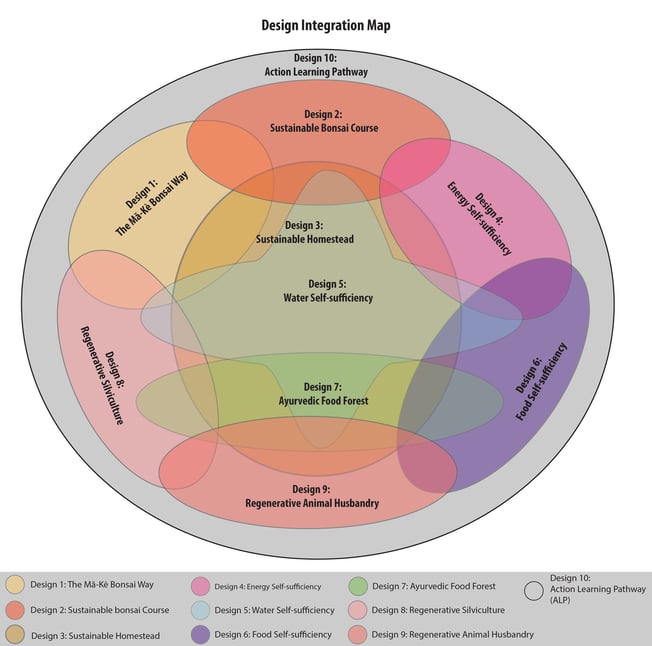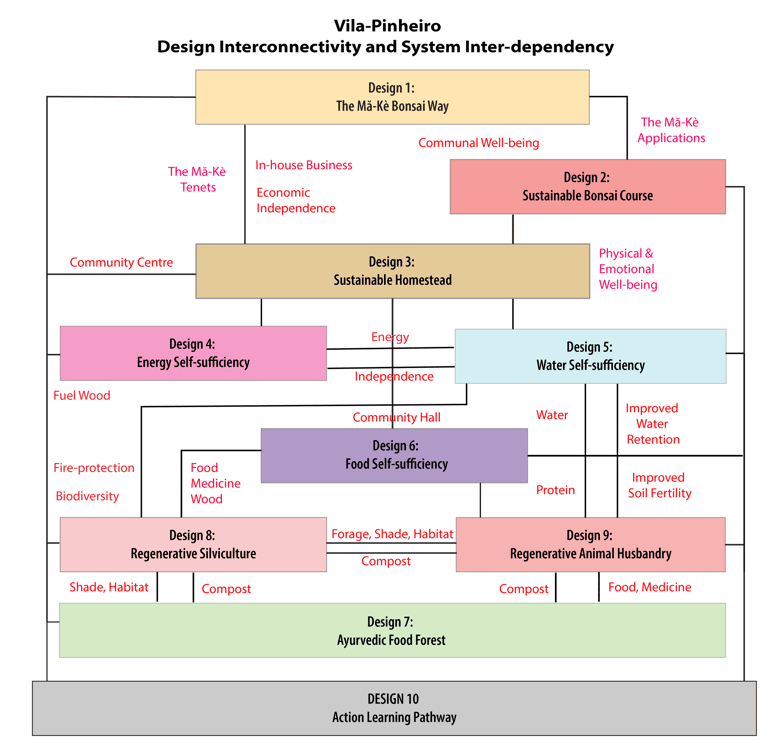
Vila Pinheiros Fruits and Compots
Vila Pinheiro
Regenerative Living,
Rooted in Permaculture
Diploma in Applied Permaculture Design
by Mark D'Cruz
Welcome to my Permaculture Diploma Portfolio
Welcome to my Diploma in Applied Permaculture Design portfolio. This site documents a journey of regeneration, rooted in the red soil of Central Portugal and shaped by permaculture ethics, ancient Vrikshayurveda wisdom, and the contemplative art of bonsai.
Over the course of this Diploma, I have developed 10 interconnected designs. Each one contributes to the living ecosystem of Vila Pinheiro, a regenerative homestead dedicated to healing land, life, and lifestyle.
Here you will find detailed design documents, appendices, diagrams, and reflections on how these systems interact, evolve, and support one another.
Designer Profile
I am a regenerative designer, educator, and technologist working at the intersection of ancient traditions and emerging systems. My journey began with the contemplative practice of bonsai and has been shaped by decades of experience in digital consultancy and education. Over time, I’ve developed a design philosophy that harmonises self, system, and soil. Drawing on Indian ecological traditions such as Vrikshayurveda and integrating them with contemporary permaculture, my approach is deeply rooted in values, culturally responsive, and systems-aware.
Cultivating Regeneration from Soil to Systems
Background and Ethos
Approach and Methodology
My design process is grounded in ethical practice and supported by frameworks such as SADIMET, as well as my original models, including GODREAMET and GRAZER. These tools reflect my commitment to cyclical, reflective learning, where observation, feedback, and transformation are part of every stage. I work iteratively and holistically, focusing not only on practical outcomes but on the relationships between land, community, and inner development.
By blending permaculture principles with action learning and pattern literacy, I design across scales – from household gardens to regional landscapes – always tailored to the cultural and ecological context of place.
Professional Experience
For over 40 years, I’ve worked internationally in information technology, strategic consultancy, and higher education. I’ve led digital transformation initiatives, delivered enterprise-scale solutions for financial institutions, and taught as a visiting lecturer in IT and systems design. These experiences have honed my ability to think critically, design systemically, and communicate across disciplines.
This background has merged naturally with my ecological practice, allowing me to create integrated systems for land regeneration, community learning, and digital engagement. I bring to permaculture both the mindset of a systems thinker and the grounded presence of a lifelong learner.
Education and Teaching
As the founder of Mă-Kè Bonsai and co-creator of Vila Pinheiro in Central Portugal, I’ve designed and delivered educational programmes in bonsai, permaculture, seed saving, and regenerative health. My teaching is accessible, experiential, and rooted in storytelling. Whether through workshops, online learning, or reflective dialogue, I invite others into deeper relationships with land, spirit, and community.
My work also explores the intersections where Ayurveda, shamanism, and permaculture intersect, fostering new conversations around health, ecology, and place-based living.
Vision and Contribution
My vision is to “Advance Regeneration through Technology” by creating tools, platforms, and spaces that empower people to co-design a regenerative future. I see design not just as a technical task, but as a spiritual and cultural act. Through Vila Pinheiro and beyond, I aim to nurture patterns of care, resilience, and renewal that grow far beyond the garden gate.
My Designs
This collection of ten permaculture designs represents a journey of regeneration: of land, of self, and the ecosystem. Rooted in the unique context of Vila Pinheiro and guided by the ethics and principles of permaculture, each design explores how traditional wisdom, practical action, and appropriate technology can converge to cultivate a resilient, living ecosystem. Together, these designs form a holistic tapestry of applied learning, adaptive thinking, and grounded hope.
Reflective Summary: What I Learned Across the Diploma
Undertaking this Diploma has been a transformative journey, one of land, learning, and self. What began as a vision to regenerate Vila Pinheiro has blossomed into a living, interconnected ecosystem of ten designs, each feeding the others, and all guided by action learning, permaculture ethics, and the spiritual resonance of Vrikshayurveda and bonsai philosophy.
Across these designs, a clear pattern of growth emerged. I moved from structured frameworks like GoSADIMET and GODREAMET into more intuitive, reflective, and cyclical approaches. Initially, the focus was on implementation and technical solutions, building water systems, growing food, and managing animals. But over time, the learning deepened. Design became less about infrastructure and more about integration. I saw how patterns, rhythms, and relationships underpin regeneration.
I learned to observe more closely, not just the land, but myself within it. Reflection became an act of design. Whether noting the compost cycles or my cycles of burnout and renewal, I began designing with presence. Tools like SWOC, PASTE, and pattern language were useful, but it was the spiral of feedback and refinement that truly embedded learning.
The process honed my humility. I embraced not-knowing. I let go of perfection. I experimented. Failed. Adapted. Learned. I transitioned from control to collaboration, allowing the goats, the trees, and the climate to become co-designers.
This journey taught me to apply permaculture beyond land, to teaching, business, ritual, and community. It validated ancient wisdom alongside emergent systems thinking. It rooted me in place while opening me to planetary resilience.
Ultimately, I have not just created ten designs—I have cultivated a designer. One who listens deeply, responds creatively, and stands ready to share this regenerative rhythm with others.
Self-Assessment Summary
An Analysis of How My Diploma Portfolio Meets the Five Accreditation Criteria
1. Completion of a Permaculture Design Certificate (PDC) and Permaculture Association Membership
I completed my PDC prior to beginning the Diploma in Applied Permaculture Design and have maintained active membership with the Permaculture Association (UK) throughout my learning pathway. This has provided access to mentorship, community events, and a broad peer network. My engagement with the Association has included tutorials, workshops, and active participation in the online guilds and design forums.
2. At Least Two Years of Applied Permaculture Practice
This portfolio documents over two years of applied practice through the development of Vila Pinheiro, my one-hectare regenerative homestead in Central Portugal. Designs were implemented in real time, responding to seasonal cycles, community needs, and ecological realities. Each design represents not just a theoretical exercise but a lived experience—observed, adjusted, and integrated over multiple years.
Design 3 (Sustainable Homestead) established the base design of the land.
Designs 4–9 focus on energy, water, food, forest, animal systems, and implementation.
Systems are being prototyped, iteratively evaluated, and actively maintained and developed.
3. Demonstration of Design Skills Across a Range of Contexts
My ten designs span educational, land-based, and economic contexts. They demonstrate versatility, depth, and originality, applying a wide range of frameworks and tools tailored to each project’s needs:
Land-Based Systems:
Design 5 (Water Self-Sufficiency) and Design 4 (Energy Self-Sufficiency) show technical skill in system design, pattern analysis, and implementation.
Designs 6 and 7 integrate Ayurvedic, ecological, and permacultural planting guilds.
Design 8 employs the GODREAMET framework in forest and coppice systems.
Non-Land-Based & Educational Designs:
Designs 1 and 2 develop regenerative philosophy and learning materials for bonsai education.
Design 10 synthesises systems thinking, reflective learning, and meta-design practices using Looby McNamara’s Design Web.
Design Tools Used: GoSADIMET, GRAZER, GOBRADIMET, Design Web, SWOC, PASTE, Zoning, Sector Analysis, DAFOR, Input–Output mapping, SMART/SMARTER goals.
Systems are being prototyped, iteratively evaluated, and actively maintained and developed.
4. Application of Permaculture in My Own Life
The Diploma has not been a side project. It is embedded into my daily life, livelihood, and values. Vila Pinheiro is not just a case study; it is my home, my family’s sanctuary, and the testing ground for every idea and intervention I present. The designs have been reshaped:
How we grow food: Ayurvedic, perennial, and seasonal polycultures (Designs 6, 7).
How we relate to animals: Animals as partners in regeneration. Integrated husbandry and silvopasture (Designs 8 and 9).
How we use energy and water: Off-grid systems with long-term resilience plans (Designs 4, 5).
How I earn and teach: I currently deliver education through The Mă-Kè Bonsai Way (Designs 1 and 2), and I am now evolving this model to integrate and expand into the field of permaculture.
This life-in-design approach demonstrates personal integration of permaculture ethics—Earth Care, People Care, and Fair Share—across practical, emotional, and spiritual dimensions.
5. Evidence of Ongoing Learning and Development of Practice
Throughout the Diploma, I have actively reflected, adapted, and evolved. The portfolio documents clear shifts:
From linear design methods to cyclical and spiral-based learning.
From individual effort to collaborative, guild-based thinking.
From reactive implementation to proactive, long-view resilience.
Design 10, my Meta-Design, provides structured insight into this development. It captures patterns, limitations, breakthroughs, and emerging directions for Vila Pinheiro as a regenerative learning hub.
I have also contributed to the broader movement through:
Mentorship conversations
Workshops
Integration of Indian ecological traditions like Vrikshayurveda
Development of original frameworks (e.g. GODREAMET, GRAZER, PERMA–SADIMET)
My journey continues through further course development, workshops, AI-regeneration research, and community integration at Vila Pinheiro.
Interconnected Ecosystems
At Vila Pinheiro, the designs do not sit in silos. They are not isolated case studies or technical checklists. They are verses in a living poem—each one echoing the others, forming a regenerative rhythm that breathes across the land.
The ten permaculture designs in this Diploma are intentionally interwoven. They inform, overlap, and strengthen one another like mycelial threads beneath a forest floor. From water harvesting to animal integration, from Ayurvedic guilds to silviculture zones, each system supports and is supported by the others.
To help visualise this systemic integration, two key diagrams are presented:




1. Venn Diagram of Zone Interactions
This graphic illustrates how each design overlaps with specific zones across the land, revealing shared functions, resources, and goals. It highlights that no area is ‘single-use.’ Instead, space is multifunctional and designed for interaction, resilience, and adaptability.
2. Systems Flow & Input–Output Map
This flow diagram maps the movement of resources—such as water, nutrients, labour, and energy—between systems. It shows how outputs from one design become inputs for another, creating regenerative loops that mimic natural ecosystems.
Together, these visuals demonstrate how Vila Pinheiro is more than a homestead. It is a regenerative organism. Ayurvedic wisdom informs forest guilds. Animal movement influences silvopasture. Water design nurtures both crop and canopy. The result is a site where permaculture, Vrikshayurveda, and ecosystem thinking operate not as parallel ideas, but as one living, breathing design.
Designing the Land as Living Poetry
Evolving the Practice of Permaculture Design
Regenerative Bonsai: Bonsai Development for Everyone
GADIE: A Closed-Loop Learning Framework for Design
GoCEAPER: A Prism-Based Framework for Regenerative Projects
PERMA–SADIMET: Evolution of Design Thinking
The Regenerative Trinity: Holistic Land Stewardship
Ayurveda and Permaculture: Health by Design
GODREAMET: Adaptive Silviculture Framework
GRAZER: Designing Animal Ecosystems with Integrity
Action Learning as Dharma: Design as a Living Spiral
Permaculture Meets AI: Amplifying Ecological Insight
AI was quietly woven throughout my process, aiding in pattern recognition, mapping, and design iterations. It didn’t replace intuition; it expanded it, opening up new regenerative possibilities in a digital world.
These ten designs are not simply expressions of regenerative intent. They are living experiments in how we design regeneration. Each project tested the boundaries of existing permaculture frameworks, and in many cases, gave rise to entirely new ones.
From GADIE and GoCEAPER and PERMA–SADIMET to GODREAMET and GRAZER, these frameworks were not lifted from manuals. They were grown from necessity, shaped by context, and refined through grounded practice.
This section highlights more than outcomes. It reveals the design thinking that made them possible and offers a glimpse into how a more adaptive and context-sensitive permaculture can emerge.
Domains of Permaculture Action
This portfolio brings together ten original permaculture designs developed during my Diploma journey. Each one explores a different facet of regenerative living, rooted in ethics, ecology, and experience. Together, they form a living system of learning, action, and reflection. Below, you’ll find them grouped into four themes that reveal the patterns behind the process.
Ten Interwoven Pathways to Regeneration at Vila Pinheiro
1. Roots & Reach
Philosophy, Teaching & Meta-Design
These designs establish the ethical, cultural, and pedagogical foundations of my work – shaping how I live, teach, and evolve as a designer.
Design 1: The Mă-Kè Bonsai Way
Art, Media, Culture and Communications, Personal development and the ‘inner transition’,
Regenerative bonsai practice is an ecological, contemplative art form grounded in permaculture ethics.
Design 2: Growing Bonsai Sustainably (Workshop)
A low-input, high-value educational workshop model fostering community learning and sustainable enterpriseDesign 10: Meta-Design & Action Learning Pathway
A reflective synthesis of all ten designs, using Looby McNamara’s Design Web to track learning and transformation.
Closing Note: A Living Journey
This Diploma has been more than a certification. It has been a living journey of the soil beneath my feet, the soul within my practice, and the systems that weave them into harmony. Each design you’ve explored here is not a conclusion, but a seed. A beginning. A gesture of hope rooted in observation, care, and the courage to act regeneratively.
At Vila Pinheiro, regeneration is not just an outcome; it is a way of being. These ten designs reflect my attempt to walk that path with integrity, learning from land, tradition, and technology alike.
If you feel drawn to explore the intersection of paths like permaculture and Ayurveda, or how AI might intersect with ecology, or where philosophy meets practical design, I’d love to connect. Whether you’re a designer, a land steward, a technologist, a teacher, or simply curious, your presence is part of the pattern. Let’s grow a regenerative future together.
Let’s grow a regenerative future together.
Get in touch or connect with me via LinkedIn
